wind SUZUKI IGNIS 2022 Owner's Manual
[x] Cancel search | Manufacturer: SUZUKI, Model Year: 2022, Model line: IGNIS, Model: SUZUKI IGNIS 2022Pages: 505, PDF Size: 8.36 MB
Page 210 of 505
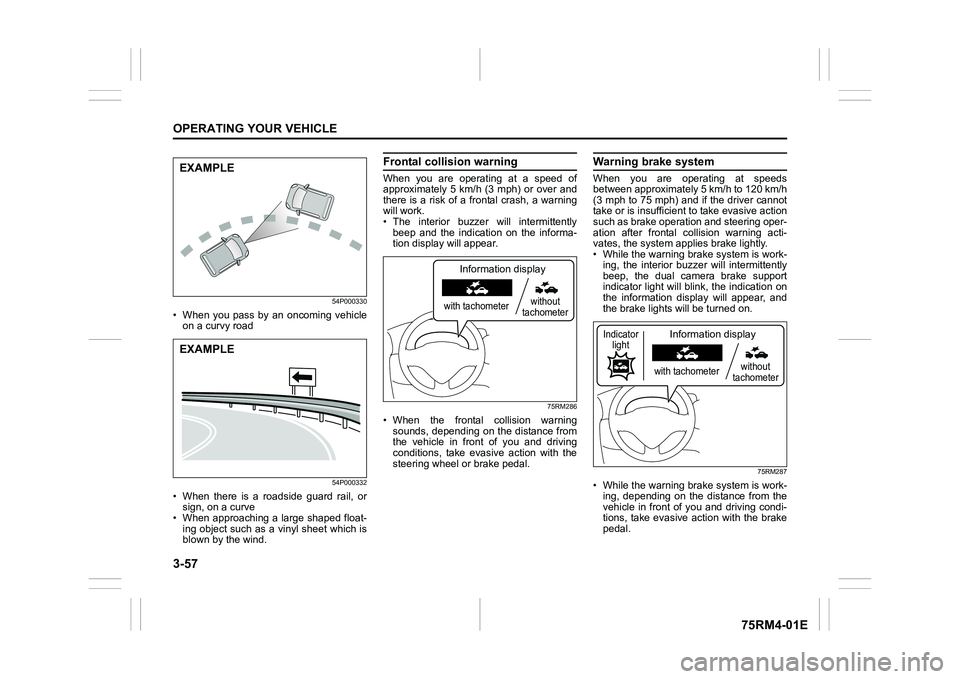
3-57OPERATING YOUR VEHICLE
75RM4-01E
54P000330
• When you pass by an oncoming vehicleon a curvy road
54P000332
• When there is a roadside guard rail, orsign, on a curve
• When approaching a large shaped float-
ing object such as a vinyl sheet which is
blown by the wind.
Frontal colli sion warningWhen you are operating at a speed of
approximately 5 km/h (3 mph) or over and
there is a risk of a frontal crash, a warning
will work.
• The interior buzzer will intermittently
beep and the indication on the informa-
tion display will appear.
75RM286
• When the frontal collision warningsounds, depending on the distance from
the vehicle in front of you and driving
conditions, take evasive action with the
steering wheel or brake pedal.
Warning brake systemWhen you are operating at speeds
between approximately 5 km/h to 120 km/h
(3 mph to 75 mph) and if the driver cannot
take or is insufficient t o take evasive action
such as brake operation and steering oper-
ation after frontal collision warning acti-
vates, the system appl ies brake lightly.
• While the warning brake system is work-
ing, the interior buzz er will intermittently
beep, the dual camera brake support
indicator light will blink, the indication on
the information display will appear, and
the brake lights will be turned on.
75RM287
• While the warning brake system is work-
ing, depending on the distance from the
vehicle in front of you and driving condi-
tions, take evasive action with the brake
pedal.
EXAMPLEEXAMPLE
with tachometer without
tachometer
Information display
with tachometer without
tachometer
Information display
Indicator light
Page 216 of 505

3-63OPERATING YOUR VEHICLE
75RM4-01E
Handling stereo camera
62R0114
(1) Stereo camera
(1)
WA R N I N G
The detection performance of the ste-
reo camera has limits and the stereo
camera cannot detect all vehicles,
obstacles or partition lines. Do not
rely excessively on the system and
always drive in a safe manner.
• Observe the following instructionsin order to keep the stereo camera
functioning properly. If mishandled,
the stereo camera cannot accu-
rately detect an obstacle or parti-
tion lines in front of you, the
system will not fu nction properly
and unexpected accidents may
occur.
– Do not touch the lens of the ste- reo camera.
– Do not clean the lens of the ste- reo camera by yourself.
– Do not strike the body of, or any surrounding parts of the stereo
camera.
– Do not remove or disassemble the stereo camera.
– Do not stick or affix anything to
the lens of the stereo camera, not
even clear items. (Continued)
WA R N I N G
(Continued)
• When the surrounding parts of the
stereo camera are deformed or
damaged, or the windshield in front
of the stereo camera is cracked
because of an accident, the stereo
camera cannot detect the front
obstacles or partition lines prop-
erly. If driving with these damaged
parts, the dual camera brake sup-
port will not function properly and
unexpected accidents may occur.
Operate the dual camera brake
support OFF switch to turn off the
dual camera brake support, and
ask your SUZUKI dealer to have
them inspected. (Continued)
Page 217 of 505
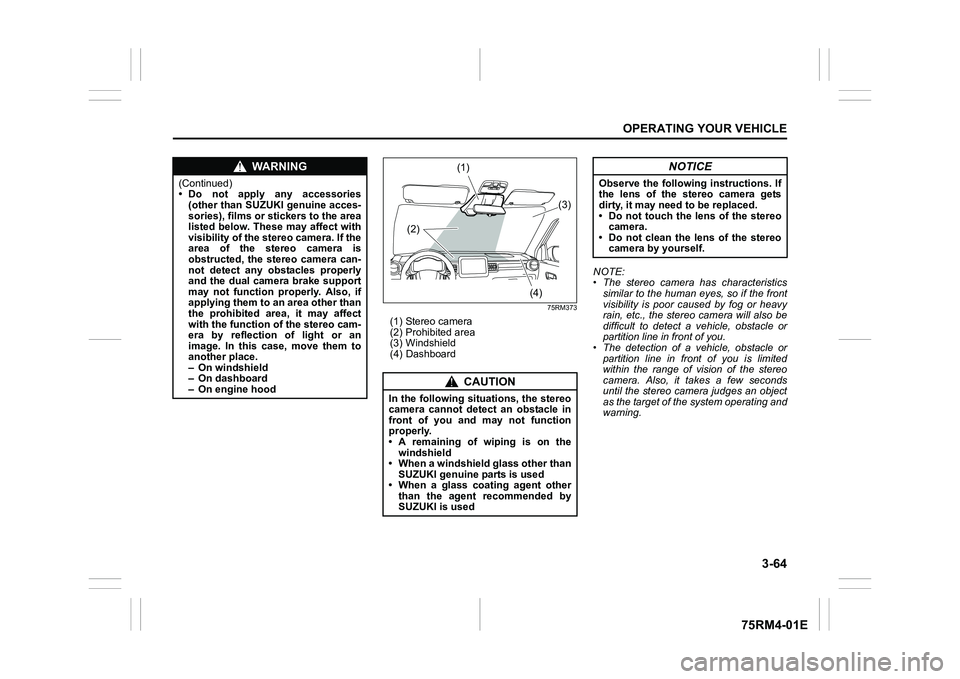
3-64
OPERATING YOUR VEHICLE
75RM4-01E
75RM373
(1) Stereo camera
(2) Prohibited area
(3) Windshield
(4) DashboardNOTE:
• The stereo camera has characteristics
similar to the human eyes, so if the front
visibility is poor caused by fog or heavy
rain, etc., the stereo camera will also be
difficult to detect a vehicle, obstacle or
partition line in front of you.
• The detection of a vehicle, obstacle or
partition line in front of you is limited
within the range of vision of the stereo
camera. Also, it takes a few seconds
until the stereo camera judges an object
as the target of the system operating and
warning.
WA R N I N G
(Continued)
• Do not apply any accessories(other than SUZUKI genuine acces-
sories), films or stickers to the area
listed below. These may affect with
visibility of the stereo camera. If the
area of the stereo camera is
obstructed, the stereo camera can-
not detect any obstacles properly
and the dual camera brake support
may not function properly. Also, if
applying them to an area other than
the prohibited area, it may affect
with the function o f the stereo cam-
era by reflection of light or an
image. In this case, move them to
another place.
– On windshield
– On dashboard
– On engine hood
CAUTION
In the following situations, the stereo
camera cannot detect an obstacle in
front of you and may not function
properly.
• A remaining of wiping is on the
windshield
• When a windshield glass other than SUZUKI genuine parts is used
• When a glass coating agent other than the agent recommended by
SUZUKI is used
(1)
(2) (3)
(4)
NOTICE
Observe the following instructions. If
the lens of the stereo camera gets
dirty, it may need to be replaced.
• Do not touch the lens of the stereo camera.
• Do not clean the lens of the stereo camera by yourself.
Page 220 of 505
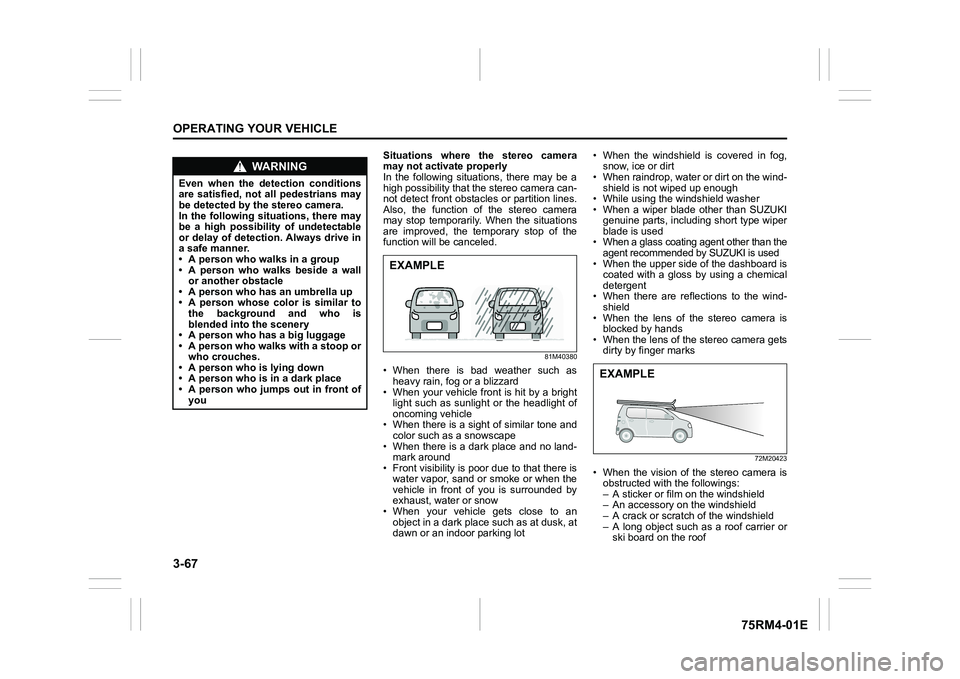
3-67OPERATING YOUR VEHICLE
75RM4-01E
Situations where the stereo camera
may not activate properly
In the following situations, there may be a
high possibility that the stereo camera can-
not detect front obstacles or partition lines.
Also, the function of the stereo camera
may stop temporarily. When the situations
are improved, the temporary stop of the
function will be canceled.
81M40380
• When there is bad weather such as
heavy rain, fo g or a blizzard
• When your vehicle front is hit by a bright light such as sunlight or the headlight of
oncoming vehicle
• When there is a sight of similar tone and color such as a snowscape
• When there is a dark place and no land- mark around
• Front visibility is poor due to that there is
water vapor, sand or smoke or when the
vehicle in front of you is surrounded by
exhaust, water or snow
• When your vehicle gets close to an object in a dark place such as at dusk, at
dawn or an indoor parking lot • When the windshield is covered in fog,
snow, ice or dirt
• When raindrop, water or dirt on the wind-
shield is not wiped up enough
• While using the windshield washer
• When a wiper blade other than SUZUKI
genuine parts, including short type wiper
blade is used
• When a glass coating agent other than the
agent recommended by SUZUKI is used
• When the upper side of the dashboard is coated with a gloss by using a chemical
detergent
• When there are reflections to the wind- shield
• When the lens of the stereo camera is blocked by hands
• When the lens of the stereo camera gets dirty by finger marks
72M20423
• When the vision of the stereo camera isobstructed with the followings:
– A sticker or film on the windshield
– An accessory on the windshield
– A crack or scratch of the windshield
– A long object such as a roof carrier or ski board on the roof
WA R N I N G
Even when the detection conditions
are satisfied, not all pedestrians may
be detected by the stereo camera.
In the following situations, there may
be a high possibility of undetectable
or delay of detection. Always drive in
a safe manner.
• A person who walks in a group
• A person who walks beside a wallor another obstacle
• A person who has an umbrella up
• A person whose color is similar to the background and who is
blended into the scenery
• A person who has a big luggage
• A person who walks with a stoop or
who crouches.
• A person who is lying down
• A person who is in a dark place
• A person who jumps out in front of you
EXAMPLE
EXAMPLE
Page 242 of 505
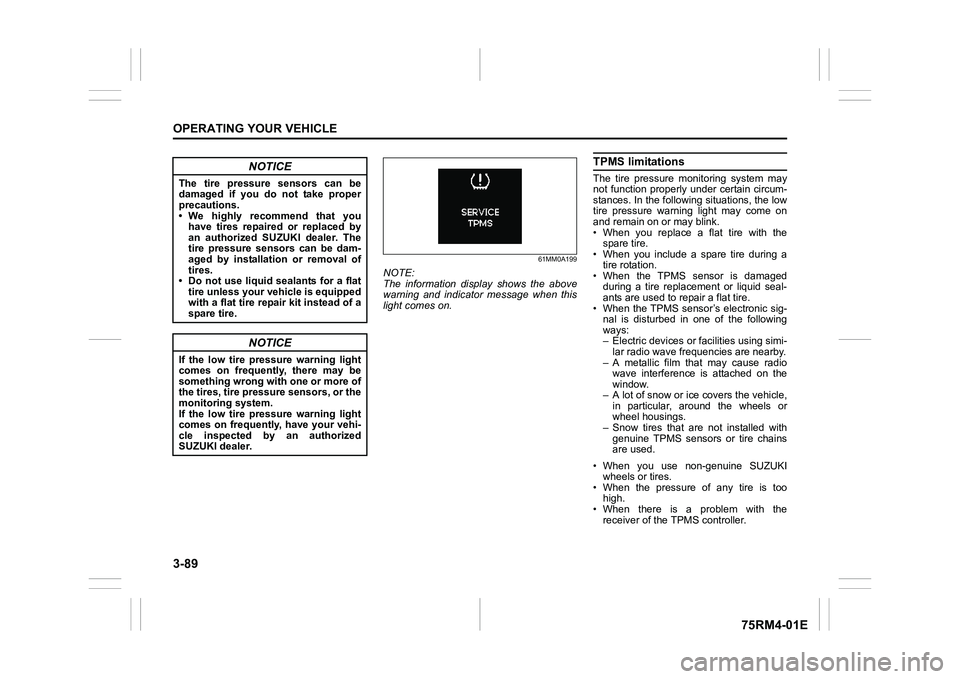
3-89OPERATING YOUR VEHICLE
75RM4-01E
61MM0A199
NOTE:
The information display shows the above
warning and indicator message when this
light comes on.
TPMS limitationsThe tire pressure monitoring system may
not function properly under certain circum-
stances. In the following situations, the low
tire pressure warning light may come on
and remain on or may blink.
• When you replace a flat tire with thespare tire.
• When you include a spare tire during a
tire rotation.
• When the TPMS sensor is damaged during a tire replacement or liquid seal-
ants are used to r epair a flat tire.
• When the TPMS sensor’s electronic sig- nal is disturbed in one of the following
ways:
– Electric devices or fa cilities using simi-
lar radio wave frequencies are nearby.
– A metallic film that may cause radio wave interference is attached on the
window.
– A lot of snow or ice covers the vehicle, in particular, around the wheels or
wheel housings.
– Snow tires that are not installed with genuine TPMS sensors or tire chains
are used.
• When you use non-genuine SUZUKI wheels or tires.
• When the pressure of any tire is too high.
• When there is a problem with the
receiver of the TPMS controller.
NOTICE
The tire pressure sensors can be
damaged if you do not take proper
precautions.
• We highly recommend that youhave tires repaired or replaced by
an authorized SUZUKI dealer. The
tire pressure sensors can be dam-
aged by installation or removal of
tires.
• Do not use liquid sealants for a flat tire unless your vehicle is equipped
with a flat tire repair kit instead of a
spare tire.
NOTICE
If the low tire pressure warning light
comes on frequently, there may be
something wrong with one or more of
the tires, tire pressure sensors, or the
monitoring system.
If the low tire pressure warning light
comes on frequently, have your vehi-
cle inspected by an authorized
SUZUKI dealer.
Page 250 of 505

4-3DRIVING TIPS
75RM4-01E
Keep the air cleaner clean
60A183S
If the air cleaner is clogged with dust, there
will be greater intake resistance, resulting
in decreased power output and increased
fuel consumption.
Keep weight to a minimum
The heavier the load is, the more fuel the
vehicle consumes. Unload any unneces-
sary luggage or cargo.
Keep tire pressures correct
Under-inflation of the tires can waste fuel
due to increased running resistance of the
tires. Keep your tires inflated to the correct
pressure shown on the label on the driver’s
side door or the driver’s door lock pillar.
Highway drivingWhen driving at highway speeds, pay
attention to the following:
• Stopping distance progressivelyincreases with vehicle speed. Apply the
brakes far enough ahead of the stopping
point to allow for the extra stopping dis-
tance.
• On rainy days, hydroplaning can occur. Hydroplaning is the loss of direct contact
between the road surface and the vehi-
cle’s tires due to a water film forming
between them. Steering or braking the
vehicle during hydroplaning can be very
difficult, and loss of control can occur.
Keep speed down when the road sur-
face is wet.
• At high speeds, the vehicle may be affected by side winds. Therefore,
reduce speed and be prepared for unex-
pected buffeting, which can occur at the
exits of tunnels, when passing by a cut
of a hill, or when being overtaken by
large vehicles, etc.
Driving on hillsManual transaxle
75RM260
Auto Gear Shift
75RM259
EXAMPLE
Page 258 of 505

5-3OTHER CONTROLS AND EQUIPMENT
75RM4-01E
75RM133
3) While holding the hood, pull the proprod out from the holding clip, and then
insert the end of the rod into the desig-
nated hole in the hood. To close the engine hood:
1) Lift the hood up slightly and remove the
prop rod from the hole. Put the prop rod
back into the holding clip.
62R0074
2) Lower the hood to about 20 cm above
the hood latch, and then let it drop
down. Check that the hood is securely
latched after closing.
CAUTION
• The prop rod can be hot enough toburn your finger right after driving.
Touch the rod after it becomes cool
enough.
• Insert the end of the rod into the hole securely. If the rod slips out,
you may get caught in the closing
hood.
• The rod may slip out when the
hood is blown by wind. Be careful
on windy days.
EXAMPLE
WA R N I N G
Check that the hood is fully closed
and latched before d riving. If it is not,
it can fly up unexpectedly during
driving, obstructing your view and
resulting in an accident.
EXAMPLE
CAUTION
To avoid injury, check that no part of
the occupant’s body such as hands
or head is in the path of the hood
when closing it.
NOTICE
Pushing on the hood from the top
may damage it.
Page 259 of 505

5-4
OTHER CONTROLS AND EQUIPMENT
75RM4-01E
Sun visor
79J161
The sun visors can be pulled down to block
glare coming through the windshield, or
they can be unhooked and turned to the
side to block glare coming through the side
window.Card holder (if equipped)
80JM152
(1) Mirror cover
(2) Card holder
You can put a card in the card holder (2) on
the back of the sun visor. Vanity mirror (if equipped)
75RM134
(3) Vanity mirror
To use the vanity mirror (3) on the back of
the sun visor, pull up the mirror cover (1).
NOTICE
When unhooking and hooking a sun
visor, handle it by the hard plastic
parts or the sun visor can be dam-
aged.
NOTICE
When you park your vehicle outdoors
in direct sunlight or in hot weather,
do not leave plastic cards in the
holder. The heat may distort them.
(1)
(2)
EXAMPLE
WA R N I N G
• Do not use the mirror while driving your vehicle or you lose control of
the vehicle.
• When using the vanity mirror, do not move too close to a front air
bag location or lean against it. If
the front air bag is accidentally
inflated, it could hit you hard.
(3)
EXAMPLE
Page 267 of 505

5-12
OTHER CONTROLS AND EQUIPMENT
75RM4-01E
Frame hooksYour SUZUKI does not recommend you
use the frame hooks for towing another
vehicle. SUZUKI was originally designed to
tow your vehicle on the road emergency
towing.
If your vehicle needs to be towed in an
emergency, refer to “Towing” in the
“EMERGENCY SERVICE” section.
Front
75RM012
The towing hook (1) is provided on the
front of the vehicle for use in emergency
situations only.
WA R N I N G
• Abrupt maneuvers or failure toproperly secure cargo can allow
the cargo to fly off the vehicle and
hit others, causing personal injury
or property damage.
• Mount cargo securely and avoid abrupt maneuvers such as jackrab-
bit starts, sharp turns, fast corner-
ing and sudden braking. Check
periodically that cargo is securely
fastened.
• Large, bulky, long or flat items can affect vehicle aerodynamics or be
caught by the wind, and can reduce
vehicle control resulting in an acci-
dent and personal injury. Drive cau-
tiously at a safely reduced speed
when carrying this type of cargo.
WA R N I N G
Observe the following instructions
when using frame hooks. The towing
hook or vehicle body may break and
cause serious injury or damage:
• Do not use the frame hooks fortowing another vehicle.
• Avoid pulling the vehicle to get out
of severe snowy, muddy or sandy
conditions, sudden starts or erratic
driving maneuvers which could
cause excessive stress on the tow-
ing hook.
In such case, we recommend that
you contact a professional service.
(1)
EXAMPLE
Page 270 of 505
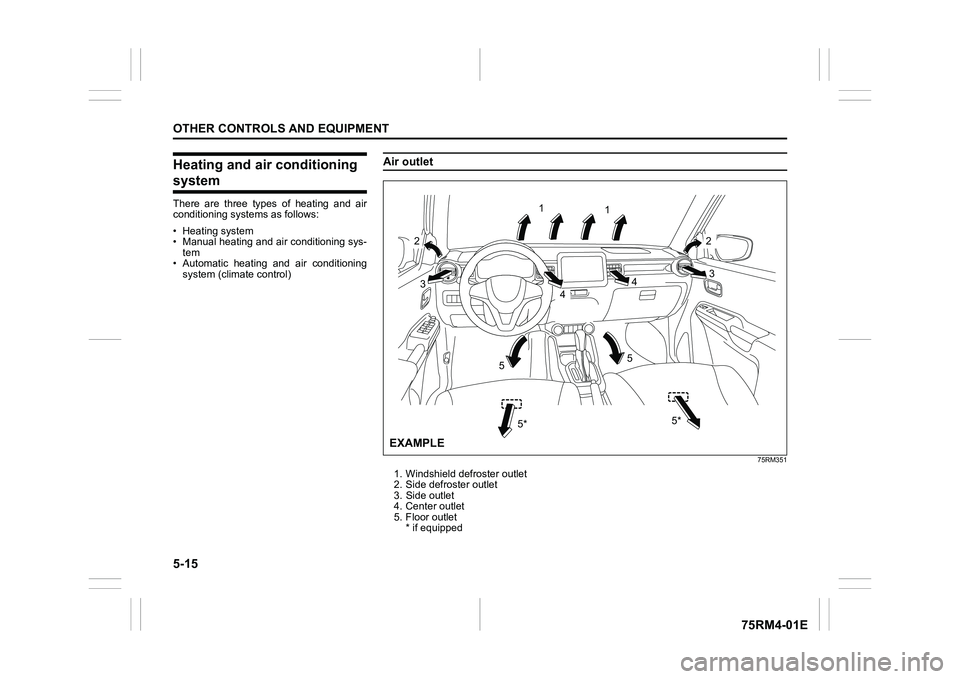
5-15OTHER CONTROLS AND EQUIPMENT
75RM4-01E
Heating and air conditioning systemThere are three types of heating and air
conditioning syst ems as follows:
• Heating system
• Manual heating and air conditioning sys- tem
• Automatic heating and air conditioning system (climate control)
Air outlet
75RM351
1. Windshield defroster outlet
2. Side defroster outlet
3. Side outlet
4. Center outlet
5. Floor outlet * if equipped
1
2 1
2
3 3
4
4
5
5
5*
5*
EXAMPLE